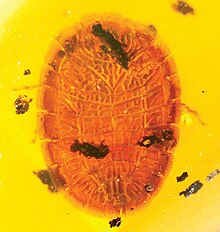Termitaphididae
| Termitaphididae | |
|---|---|

| |
| Termitaradus mitnicki female in Dominican amber | |
| Scientific classification | |
| Domain: | Eukaryota |
| Kingdom: | Animalia |
| Phylum: | Arthropoda |
| Class: | Insecta |
| Order: | Hemiptera |
| Suborder: | Heteroptera |
| Superfamily: | Aradoidea |
| Family: | Termitaphididae Myers, 1924 |
| Genera | |
Termitaphididae, occasionally called termite bugs,[1] is a small tropicopolitan family of true bugs placed in the superfamily Aradoidea. Typically members of Termitaphididae are small, being an average of 2 millimetres (0.079 in)-4 millimetres (0.16 in), and flattened with laminae extending out from each body segment giving a round scale like appearance. Currently the family contains two genera and twelve known species.[2] Members of Termitaphididae are inquilines lodging in the nests of host species of termite families Termitidae and Rhinotermitidae. Though considered a separate family in Aradoidea it has been suggested by Drs David Grimaldi and Michael Engel in 2008 that Termataphididae may in fact be highly derived members of Aradidae.[2] Of the thirteen known species one Termitaphis circumvallata belongs to the monotypic genus Termitaphis and four of the remaining eleven species in Termitaradus are extinct, having only been found in amber.[2][1] The living species are found worldwide in the tropical regions of Central and South America, Africa, Asia, and Australia.[2]
References
- ^ a b Poinar, G.; Heiss, E. (2011). "New Termitaphididae and Aradidae (Hemiptera) in Mexican and Dominican amber" (PDF). Palaeodiversity. 4: 51–62.
- ^ a b c d Engel, M.S. (2009). "A new termite bug in Miocene amber from the Dominican Republic (Hemiptera, Termitaphididae)". ZooKeys (25): 61–68. doi:10.3897/zookeys.25.267.
